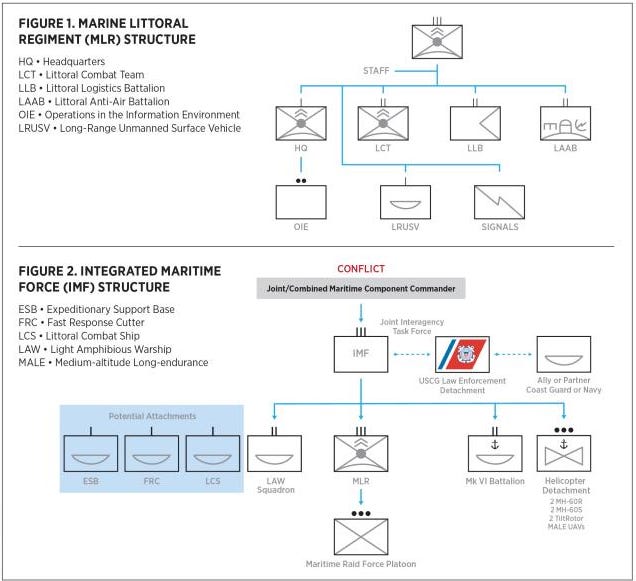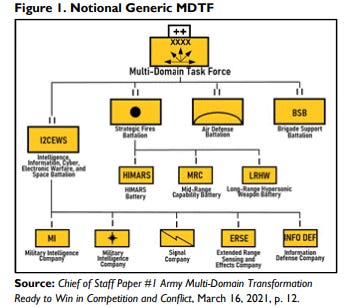U.S. Marine Corps and U.S. Army Deployments in the Pacific
Both services creating new organizations for action in the western Pacific
The U.S. Navy and U.S. Air Force Pacific brass need to put away the fine china and hide the silverware, because the DOD is sending in the U.S. Marine Corps and the U.S. Army! The navy and air force are still in the process of pivoting to the western Pacific to face an increasingly militarily capable and aggressive People’s Republic of China. In coordination with the Defense Department, the U.S. State Department and the National Security Council, or NSC, have largely led the U.S. in forming alliances and agreements with countries in the western Pacific and Indo-Pacific, with the aim of containing China's strategy. The U.S. Navy and Air Force have also been improving their capabilities in the region. These two services were expected to be the lead services in any confrontation with China due to the potential battlefield spanning the vastness of the western Pacific Ocean; however, the issues facing the Navy and the Air Force that are not quickly remedied have created a situation in which the Marine Corps and Army are envisioned to have a critical role in defending the western Pacific.
It will be difficult for the U.S. military to operate far from its shores against China, its main rival, which will have the advantage of operating in its “backyard” and having interior lines in the expected contested space. China has the second largest economy in the world, the second largest military budget, and an industrial base to produce the weapons it needs. China's commitment to building a large and capable military is not solely for self-defense but also serves as a military and political tool, enabling its leadership to assert expansive claims in the region that are advantageous to China. China is a communist country, though it is a bastardized version of it, which blurs the lines between military and political authority when compared to the much more clearly defined roles of its western counterparts. However, like the West, China practices economic leverage, soft diplomacy, and the Clausewitzian view of the role of hard power as an alternative method for achieving political objectives.
China's Communist Party, with its character to blur the boundaries between military and political matters, frequently employs tactics such as economic coercion, gray zones, and paramilitary and military force to intimidate its neighbors, as well as occasionally Australia and the U.S., China’s main focus, though, is directed toward Taiwan, where it uses all forms of pressure to bring the island to heel and submit to its control.
Recently, China has adopted a more militarily focused and bellicose stance towards Taiwan, posing a threat to Taiwan's independence through escalatory actions, military threats, unannounced exercises, and incursions into its sovereignty. China's escalatory actions include unilaterally altering the W122 and W123 civilian air routes, regularly intruding into Taiwan's ADIZ (Air Defense Identification Zone), and conducting unannounced military exercises that simulate both air and sea blockades, as well as a mock invasion of the island nation, with the intention of disrupting Taiwan's air and sea traffic. China's aggression extends beyond Taiwan, as it consistently poses a threat to neighboring countries by asserting its sweeping and illegal claims of absolute sovereignty over the South China Sea through the "Nine Dash Line," which impacts Vietnam and the Philippines. Additionally, it has ongoing territorial disputes with Japan.
The challenges of the U.S. Navy and Air Force are so extensive in the far-flung region that the Pentagon has sought alternatives to enhance its capabilities to contain an aggressive China. The U.S. Marine Corps and the U.S. Army are in the process of adopting new force structures that will allow them to become active participants in the containment strategy against China or to play a key role to contest China if hostilities do break out in the region. The new force structure for the USMC is the Marine Littoral Regiment, and for the army it is the Multi-Domain Task Force.
The Marine Corps has a longstanding tradition of securing the Pacific region and conducting warfare at sea. Given the nature of China's threat, it was initially unclear how the Marines would contribute, beyond bolstering the Navy's air assets with Marine fighter aircraft. This is because the threat from China is based on operations in and around Taiwan. Taiwan is a part of the First Island Chain, and in order for China to effectively advance its agenda into the South China Sea and the north and east of the Pacific, it will need to breach the First Island Chain, which necessitates the occupation of Taiwan.
Unless the United States deploys troops into Taiwan itself, the USMC will not participate in amphibious warfare during a conflict over Taiwan. During World War II, U.S. Navy Admiral Spruance drew up plans to invade the island of Formosa, now known as Taiwan, and there were so many impractical reasons to conduct such an operation from the sea that he rejected the idea. The issues that Admiral Spruance cited in his operations plan are still valid today. The issues that hinder a U.S. operation are not a concern for China, as it has major ports facing Taiwan and only needs to project force across the Taiwan Straits, eliminating the need for a seaborne supply chain.
In contrast to a Marine Expeditionary Unit, or MEU, the Marine Littoral Regiment, or MLR, operates as a "stand-in force" on islands in the western Pacific, including smaller islands in Japan and the Philippines. These units will be less about the fighting tradition of the Marines but will be more about support, as the MLRs are expected to conduct support missions for both maritime domain awareness and the information environment, support surface warfare by conducting surface-to-ship missile strikes, and participate in missile strikes and be part of an air and missile defense in its area of operation.
The MLR will maintain a minimal presence in its operations on the islands it deploys, and it will rely on autonomous semi-submersible resupply boats, currently undergoing testing in Okinawa, for self-sustenance. The MLR will consist of approximately 2,000 Marines, and the current objective is to establish three MLRs with the following deployment locations:
• 3rd MLR located in Hawaii since 2022
• 12th MLR in Okinawa, Japan, since 2023
• 4th MLR planned for Guam in 2027
The U.S. Army maintains large forces in the Pacific region but serves a different role than the traditional role of the Marine Corps. The army is less focused on amphibious operations but is available for operations on the Korean Peninsula, a deterrent force for theater security, and support operations. Like the Marines, the Army is transitioning into multi-domain operations, coordinating military activities across land, sea, air, space, and cyberspace domains. In the Pacific region, the Army, similar to the Marines, is assuming a more supportive role. They have established a new organizational structure that can function as both an offensive and a support organization, depending on the specific mission. The Multi-Domain Task Force, or MDTF, is the name of the new organization.
The MDTF structure is similar to the MLR structure but does have some differences. MDTF will have military intelligence assets assigned to it that are not present in the MLR structure. HIMARS, Typhon, and eventually long-range hypersonic weapons will equip it with a longer-range strike capability. Due to its lack of dedicated anti-ship capability, it will likely be less effective at maritime interdiction than the MLR. MDTF will also have a flexible force structure that will add or remove elements depending on the mission. For example, a mission in the Philippines to defend Taiwan would not necessarily need a HIMARS battery due to the expanse of the Pacific. The addition of an MDTF to the western Pacific would enhance its capabilities in air and missile defense, mid- and long-range strike, and force coordination with other U.S. forces and allies.
A big difference between the MDTF and the MLR is that the MLR creates a much smaller footprint and is being developed to have the capability to have a low-footprint resupply system. This means that it can operate in locations that the MDTF would not be able to operate effectively. The MDTF, like most Army units, will have a larger footprint and require a clearly defined resupply base. The supply requirement can be reduced as the MDTF force structure is flexible, but it would be envisioned that it would need at least access to a port or an airfield while operating in the Pacific. Below are the plans for the creation of the MDTF:
• 1st MDTF located at the Joint Base Lewis-McChord in Washington
• 2nd MDTF located at Wiesbaden, Germany, and Fort Drum, NY, to support activities in Europe and Africa
• The 3rd MDTF will be headquartered in Hawaii, with units located in both Hawaii and Joint Base Lewis-McChord. To be fully operational in 2026.
• The 4th MDTF will be located at Fort Carson, Colorado, with a focus on the Indo-Pacific. To be fully operational in 2027
• The 5th MDTF will be located in Fort Liberty, North Carolina, and will not have a designated region for support. To be fully operational by 2028.
The Marine Corps and Army are operating beyond their traditional roles, implementing force structures that will enable both services to have significant roles in mid- and long-range strike missions, air and missile defense, and maritime interdiction. This means that both services will have a credible anti-access/area denial, or A2/AD, capability to support navy and air force operations. These new force structures, are not without controversy, will not replace the primary role of the navy and air force in the Pacific Theater, but they will enhance both services by allowing them to concentrate their assets and adding a significant strike capability that can operate throughout the Pacific, potentially serving as an additional deterrent to prevent hostilities from escalating over Taiwan.
MLR Structure:
Source: The U.S. Naval Institute
MDTF Structure:
If you like my content, please consider becoming a Substack subscriber to Pegasus Research or support me through Patreon, Buy Me A Coffee or Ko-Fi.
References:
https://www.marines.mil/News/News-Display/Article/2708002/dynamic-force-employment/
https://www.marines.mil/News/News-Display/Article/2708146/marine-littoral-regiment-mlr/
https://www.newsweek.com/us-news-makes-missile-plan-eye-chinese-invasion-taiwan-1990953
https://sgp.fas.org/crs/natsec/IF11797.pdf
https://www.military.com/daily-news/2024/10/16/marine-corps-unmanned-narco-boat-now-plying-waters-around-okinawa.html
https://stefanik.house.gov/2023/12/following-her-strong-advocacy-stefanik-announces-new-multi-domain-task-force-at-fort-drum






